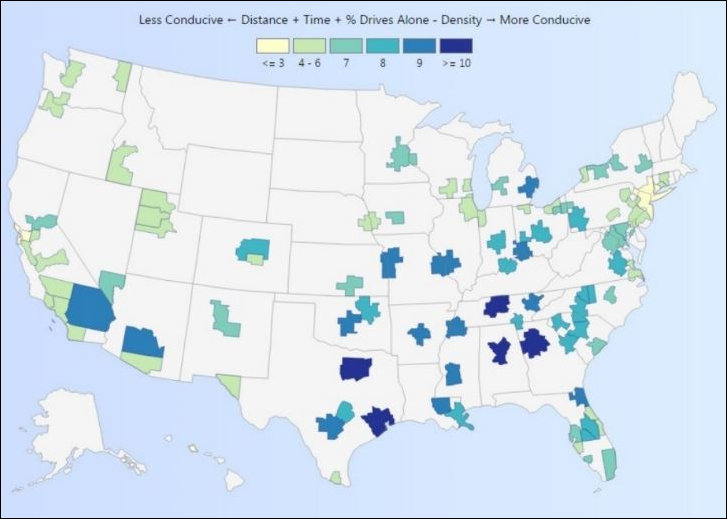by James A. Bacon
Uber and Lyft, known mainly for providing taxi-like services, may find sprawling Sun-Belt cities to be the most hospitable markets for their new car-pooling services. That’s one of the conclusions arising from a new Morgan Stanley report on the proliferation of Uber- and Lyft-style services across the United States. The logic: Sun Belt cities have low-density human settlement patterns that will not support mass transit but have congested roads that could benefit from carpooling.
I can’t find the study itself on the Web, but a number of media outlets have reported on it, including this article by Myles Udland published for Business Insider and re-published in Slate. Writes Udland:
Uber and Lyft could have the biggest impact in the South. Instead of getting in your car and driving to work, or replicating the Northeast commuting experience of driving or walking to a train and heading into the city, more sprawling metros could enact large-scale, commuter-targeted versions of what is basically Uber Pool — Uber’s “carpool” option where you set a pick-up and destination and your driver is able to make pick-ups and drop-offs along the way.
In Uber own estimation, the implications of UberPool are “profound.” “On average, uberX already costs 40% less than taxi. Imagine reducing that cost by up to another 50%! In San Francisco, how about $6 to Uber from the Castro to the Financial District? Or $10 from Sunset to SOMA? At these price points, Uber really is cost-competitive with owning a car, which is a game-changer for consumers.”
But as Morgan Stanley observes (and Uber overlooks in its example) the metros most likely to benefit from UberPool and competing services are those that, unlike San Francisco, lack mass transit alternatives. Further, suggests Morgan Stanley, those cities would be well advised to invest in building networks of ride-sharing services rather than commuter rail. (I’m not certain what carpooling infrastructure would look like — perhaps dedicated locations analogous to bus stops where car-pooling cars and vans can pick up and drop off passengers without disrupting traffic flow.)
According to the Morgan Stanley metrics, as visually summarized in the map above, Virginia metros are not prime candidates for Uber-like carpooling. Yet I have long argued that Uber-like ride sharing services are exactly what our metros need. Outside the urban core served by METRO much of Northern Virginia could use UberPool. Richmond and Hampton Roads, with much weaker mass transit backbones, would be even more suitable.
There is no one-size-fits-all transportation solution for Virginia. And, while I prefer a Smart Growth vision for future development and re-development, I acknowledge that not everyone shares my refined urban sensibilities. I also acknowledge that it takes decades and billions of dollars to transform suburban sprawl into communities that can support mass transit. In the meantime, Uber-inspired carpooling may be the most cost effective way of meeting the transportation needs of millions of suburban Virginians.



